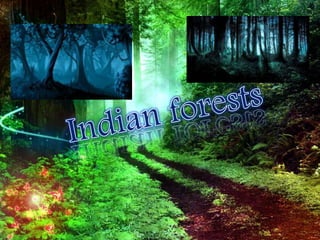
Indian forets
- 2. What is forest? Indian forest India’s rank in world forest Conservation of forest Classification of forest Deciduous forest Evergreen forest Mangrove forest Thorn forest Sub tropical forest Coniferous Forest
- 3. The forest is a complex eco system consisting mainly of trees that buffer the earth and support a myriad of life forms. It is also the community of trees, shrubs, herbs, and associated plants and organisms that cover a considerable area that use oxygen, water and soil nutrients as the community attains maturity and reproduces itself.
- 4. The forest in India are ancient in nature and composition. Each Indian forest are rich in variety and shelter a wide range of fauna, avi-fauna and insects. The fact that they have existed for very long time is proved from the ancient texts all of which have some mention of the forests. The people revered forests in India and a large number of religious ceremonies centred on trees and plants. Even today in parts of India the sacred groves exist and are worshipped.
- 5. India rank’s 10th in the list of most forested nations in the world with 76.87 million hectares of forest and tree cover. India’s forest cover accounts for about 23.44% of the total geographical area of the country. With nearly 173,000 villages classified as forest fringe villages, there is obviously
- 8. Massive afforestation work should be undertaken to cover large areas of land with useful plants. for example: they are planted along the highways and rivers, around the playgrounds and parks.
- 9. What is the common thing between these examples ? The common thing is that the trees are planted in a place which are unfit for the agriculture.
- 11.
- 13. Forest fire should be prevented. Huge forest areas are destroyed by fire every year. Fire may caused due to carelessness of the people or by natural methods. People should avoid smoking and cooking in the forest areas.
- 15. •Overgrazing by cattle, horses, sheep's and goats should be prevented.
- 16. What is soil erosion? Gradually wear away of soil is called soil erosion.
- 17. All activities leading to soil erosion should be controlled.
- 18. Forest must be protected from insects and pest. The infected plants should be removed or treated with suitable pesticides.
- 19. Air water and soil pollution should be reduced so that the trees and other vegetarian can survive and develop in the forest.
- 20. The types of forests depends on total amount of rainfall received. Forests can be classified into the following types: Deciduous forests Ever green forests Mangrove forests Thorn forests Sub tropical forests Coniferous forests
- 21. Deciduous means "falling off at maturity or "tending to fall off", and it is typically used in order to refer to trees or shurbs that lose their leaves seasonally (most commonly during Autumn) and to the shedding of other plant structures such as petals after flowering or fruit when ripe. In a more general sense, deciduous means "the dropping of a part that is no longer needed" or "falling away after its purpose is finished". In plants it is the result of natural processes
- 22. An evergreen forest is a forest consisting entirely or mainly of evergreen trees that retain green foliage all year round. Such forests reign the tropics primarily as broadleaf evergreens, and in temperate and boreal latitudes primarily as coniferous evergreens.
- 23. Mangroves are various large and extensive types of trees up to medium height and shrubs that grow in saline coastal sediment habitats in the tropics and subtropics – mainly between latitude 25° N and 25° S. The remaining mangrove forest areas of the world in 2000 was 53,190 square miles (137,760 km²) spanning 118 countries and territories.
- 24. A thorn forest is a dense, scrub like vegetation characteristic of dry subtropical and warm temperate areas with a seasonal rainfall averaging 250 to 500 mm (9.8 to 19.7 in). In South America, thorn forest is sometimes called Caatinga and consists primarily of small, thorny trees that shed their leaves seasonally. Trees typically do not exceed 10 meters (33 ft) in height, usually averaging between 7 and 8 meters (23 and 26 ft) tall.
- 25. Tall stands of Subtropical Rainforest occur from the cooler uplands of northern Queensland to the lowlands of the New South Wales coast. They are best developed in environments with both fertile soils and high rainfall. Because they share many species and characteristics in common, there is no clear-cut boundary between Tropical and Subtropical Rainforests. In general, the latter community has less of everything that is typically found in Tropical Rainforests
- 26. Coniferous forest, vegetation composed primarily of cone-bearing, needle-leaved, or scale-leaved evergreen trees, found in regions of the world that have long winters and moderate to high annual precipitation. The northern Eurasian coniferous forest is called the taiga, or the boreal forest. Both terms are used to describe the entire circumpolar coniferous forest with its many lakes, bogs, and rivers. Coniferous forests also cover mountains in many parts of the world. Pines, spruces, firs, and larches are the dominant trees in coniferous forests
- 29. We would like to express our special thanks of gratitude to our teacher Mrs.Meenakshi Bhatia mam who gave us the opportunity to do this wonderful project on the topic forest which helped all of us to know new things about forest.